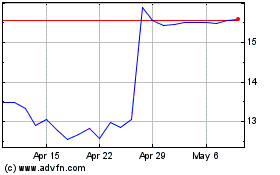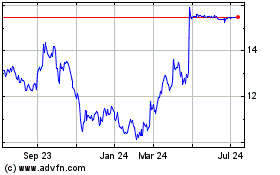Frac Sand Miner U.S. Silica Trading Down Post-IPO
February 01 2012 - 10:30AM
Dow Jones News
The sand used in oil and gas well fracturing didn't cause much
excitement among investors Wednesday, with shares of U.S. Silica
Holdings Inc. (SLCA) sticking close to its IPO price in early
trading.
The company's stock opened at $17.25 on the New York Stock
Exchange, up 1.5% from its initial-public-offering price of $17,
but soon sank lower, changing hands recently at $16.93 a share,
down less than 1%. A total of 11.8 million shares were sold at the
midpoint of its $16-to-$18 price range.
Two other offerings expected to begin trading Wednesday,
biopharmaceutical developer Merrimack Pharmaceuticals Inc. and oil
and gas production company Dynamic Offshore Resources Inc., were
postponed after failing to price Tuesday night.
U.S. Silica specializes in commercial silica--essentially,
sand--that is used in a variety of industries, the most prominent
being oil and gas. The company's "frac sand" is used to stimulate
oil and gas wells that are in shale formations, and it claims to be
one of the few commercial producers capable of rail delivery of
large quantities of the material to each of the major U.S. shale
basins.
Strong demand for frac sand has led U.S. Silica to invest in
expanding its production by 75% over 2010 levels and to build a new
facility that makes resin-coated sand, another area of market
growth. The company plans to use a portion of its IPO process to
help build the facility and to fund future capital spending at the
firm.
U.S. Silica is the second-largest domestic producer of
commercial silica, and while frac sand accounts for nearly half of
its business, the company also makes silica for glassmaking,
chemical manufacturing, solar panels, wind turbines, specialty
coatings and geothermal energy systems.
U.S. Silica says it has a low-cost operating structure because
it owns most of its sand reserves and locates its processing
facilities close to its mines. It expects demand to rise for its
frac sand as more horizontal wells are drilled using fracturing
techniques, well length increases due to advances in drill
technology, and more frac sand is used per foot.
The economic downturn of 2008 and 2009 did decrease demand for
commercial silica products, particularly in the glassmaking,
foundry, specialty coatings and building products. Since 2010, as
the general economy has continued to recover, demand has once again
begun to grow in most of these end markets, and the company has
seen more new demand in products ranging from solar panels to
polymer additives.
One positive effect of the economic downturn is that decreased
demand for commercial silica from various industries put a lid on
any significant supply expansion. When demand grew for frac sand
and rebounded in other markets beginning in 2010, supply failed to
keep pace with demand, a condition that has persisted for the last
18 months. U.S. Silica and other producers have begun to expand,
but the industry faces capacity constraints, ranging from finding
silica reserves that meet frac sand standards, to finding reserves
that are large enough and located close enough to transportation to
justify development.
As a result, prices have increased at an average annual rate of
9% between 2000 and 2009; if demand for frac sand continues to
rise, and if the general economic recovery continues to result in
increased demand from other industries, U.S. Silica expects prices
to go even higher.
In the first nine months of 2011, sales increased 14% to $212
million, and profit more than doubled to $20 million.
The company's growth through frac sand is not without its risks.
If oil prices contract, high-tech hydraulic methods to drill wells
in shale may prove too expensive, and demand for frac sand would
fall. Other methods that use different materials to stimulate wells
could replace frac sand.
Three-quarters of U.S. Silica's IPO shares were sold by previous
owners, so the company won't receive those proceeds. The major
seller was private equity firm Golden Gate Capital.
Morgan Stanley (MS), Bank of America Merrill Lynch and Jefferies
Group Inc. (JEF) were joint bookrunners on U.S. Silica's
offering.
-By Lynn Cowan, Dow Jones Newswires; 301-270-0323;
lynn.cowan@dowjones.com
Silica (NYSE:SLCA)
Historical Stock Chart
From Jun 2024 to Jul 2024

Silica (NYSE:SLCA)
Historical Stock Chart
From Jul 2023 to Jul 2024
